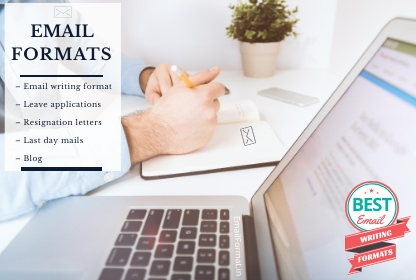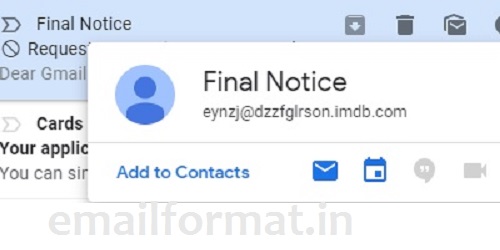1. Find Your Business Email Audience
You must know to whom you are sending the email. Who all are the recipient's of this mail and who all are needed
to be copied in this email. If you are sending an email to an individual then no need to use 'CC' and 'BCC' fields.
But in case you are not receiving any replies from an individual and you wanted to highlight or escalate it to his/her
manager, then that manager should in 'CC'. 'BCC' is used when you don't want each recipient to know that who all are
other recipients for the email.
To:
anushka.sharma@emailformat.in
2. Use Your Professional Email address
Your professional email address should be a combination of your real name, not a username or nickname. Make
use of separators like periods, hyphens, or underscores to secure an email address without extra numbers or letters.
Most of the organizations provides the email addresses with your names.
For example, niceg18@emailformat.in will seem unprofessional whereas virat.kohli@emailformat.in is suitable
From:
virat.kohli@emailformat.in
3. Subject line for email
Grab attention with the subject line. The first part of an email which your recipient sees is the subject of the email.
If you do not put it well, you risk having your email not opened until later or at all.
Don't forget to include a Subject Line in your email.
If you forget to include one, your message probably isn't even going to get opened.
Use the subject line to summarize why you're emailing.
Few tips on subject line
-
The subject line should be short
-
Make the subject line specific, simple, and to the point.
-
Use prefixes like Important, Urgent, Risk, Issue or Notice to further narrow down the subject. It informs your recipient about the urgency and nature of your email.
Some examples of strong subject lines:
-
Resignation - Maya Shulj
-
Work from home on 17th and 18th January
-
AWS account creation request
Subject:
Resignation - Maya Shulj
4. Use Professional Font
Make sure that the email format is written in a font which is easily readable to any of the recipients.
Don't try to use artistic or fancy fonts. For a professional email, use
fonts like Arial, Times New Roman and Verdana.
5. Begin with a greeting
Always open your email with a greeting as it is directed towards someone.
Do not skip the greeting and always be respectful.
For people you are unfamiliar with or do not know the names of, use 'To Whom It May Concern' or 'Dear sir/madam'.
For senior officials, stick to their designation or follow it with their name, for example, 'To the Manager',
'Dear Ms. Khanna', or 'Dear Dr. Raheja'.
For colleagues, it may be appropriate to simply prefix the name with a 'Hi'.
Hi Virat,
6. First paragraph - introduce yourself (if required)
If you are writing an email to someone you don't have an existing relationship with, such as a new manager, cross functional manager,
new customer, recruitment manager, or government official, tell them who you are and why you are writing email.
Do this in the first sentence or two of your email format.
I am Neha Dee from Skyclouds project team of ACT business unit.
7. Second paragraph - Set the context with purpose In Your Email Format
Email writing should begin by stating your purpose like, “I am writing to know about ...”
or “In reference to your mail dated ...".
Avoid overly complicated or long sentences. Make it easy for email recipients to
quickly scan through your email and know why you're emailing. It’s ok to be direct in writing email,
get to the point as long as you are polite.
I am writing this email to know about the upcoming training on "Professional Email Format".
As a part of my individual development plan, I need to complete this training in 2019.
8. Third paragraph - Always Include A Closing Statement In Your Email Format
Before you end your email, it’s polite to thank your reader with some polite closing remarks.
Professional Closing statements in your email format include:
-
I await your reply with interest
-
Thanks for your extremely helpful attention to this matter
-
I am looking forward to getting your input on this issue
-
It's always a pleasure doing project with you
-
Thanks again for sharing your expertise in this matter
-
Let me know in case you have any queries
-
I look forward to hearing from you
-
Thank you for your patience and cooperation
-
I look forward to our next meeting
-
Looking forward to our successful partnership
-
Thanks again for your attention, consideration, and time
-
We look forward to building a strong business relationship in the future
-
If you have any questions or concerns, don’t hesitate to let me know
If you have any questions or concerns, don’t hesitate to let me know.
9. Include an Email Signature in your email format
It's important to create an email signature and to include your signature with every
email you send. Email signature includes your name, your address, and your phone number
in your email signature, so the recipient can see, at a glance, how to contact you.
Optionally it is advisable to include your designation so that recipient knows the authenticity
and authority of the email.
As with salutations, there are a variety of closings that are acceptable in formal email formats.
Potential Signature closings in professional email format include:
-
Regards
-
Yours sincerely
-
Yours cordially
With Regards,
Anushka Sharma
YashRaj, Virat Towers, Rab ne bana di jodi Marg, Mumbai - 464644
Mobile - +91 000000000
10. Include attachments (if required)
If you need to include any attachments, don't simply attach it. Make sure to mention them
in the body of the email format to let the recipient know that they are included.
Be courteous by trying to keep the number of attachments and their file size minimum, and
by using common or widely compatible file types.
Make sure to double-check that you have attached all the files mentioned in your email before hitting the "send" button.
Please find attached the sample email format template for your reference.
11. Final scan with spell check and send email
Finally, before you hit the send button, review and spell check your email to make sure it’s truly perfect!









